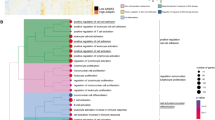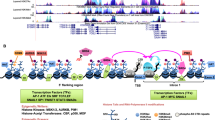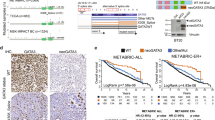Abstract
Expression of survivin, a member of the inhibitor of apoptosis protein family, is elevated in human cancers and considered as a new therapeutic target. Mechanism upregulating survivin expression in tumour cells is poorly understood. In this study, we show that breast cancer patients harbouring a polymorphism G235A in the survivin promoter present a higher level of survivin expression. This polymorphism creates a binding site for the transcription factor GATA-1 inducing a second GATA-1-binding site in survivin promoter. At the mRNA level, GATA-1 was present in breast carcinomas and adjacent normal tissues, whereas the protein was only detected in carcinomas by western blot and immunohistochemistry. Transfection of wild-type and different constitutively active GATA-1 mutants (serine 26, 178 or 310) showed that only phospho-serine 26 GATA-1 was able to increase survivin expression. This increase was higher in G235A than in G235G cell lines. Phospho-serine 26 GATA-1 bound directly survivin promoter, with a stronger interaction in G235A than in G235G polymorphism indicating that both GATA-1-binding sites are functional. These data identify GATA-1 as a key feature in tumour aggressiveness by enhancing survivin expression and delineate its targeting as a possible new therapeutic strategy in breast carcinomas.
This is a preview of subscription content, access via your institution
Access options
Subscribe to this journal
Receive 50 print issues and online access
$259.00 per year
only $5.18 per issue
Buy this article
- Purchase on Springer Link
- Instant access to full article PDF
Prices may be subject to local taxes which are calculated during checkout






Similar content being viewed by others
References
Altieri DC . (2003). Survivin in apoptosis control and cell cycle regulation in cancer. Prog Cell Cycle Res 5: 447–452.
Altieri DC . (2005). T cell expansion: the survivin interface between cell proliferation and cell death. Immunity 22: 534–535.
Altieri DC . (2008). Survivin, cancer networks and pathway-directed drug discovery. Nat Rev Cancer 8: 61–70.
Altieri DC, Marchisio PC . (1999). Survivin apoptosis:an interloper between cell death and cell proliferation in cancer. Lab Invest 11: 1327–1333.
Ambrosini G, Adida C, Altieri DC . (1997). A novel anti-apoptosis gene, survivin, expressed in cancer and lymphoma. Nat Med 3: 917–921.
Boidot R, Végran F, Jacob D, Chevrier S, Gangneux N, Taboureau J et al. (2008). The expression of BIRC5 is correlated with loss of specific chromosomal regions in breast carcinomas. Genes Chromosomes Cancer 47: 299–308.
Boidot R, Végran F, Lizard-Nacol S . (2009). Predictive value of survivin alternative transcript expression in locally advanced breast cancer patients treated with neoadjuvant chemotherapy. Int J Mol Med 23: 285–291.
Chiba T, Ikawa Y, Todokoro K . (1991). GATA-1 transactivates erythropoietin receptor gene, and erythropoietin receptor-mediated signals enhance GATA-1 gene expression. Nucleic Acids Res 19: 3843–3848.
Ciocca DR, Calderwood SK . (2005). Heat shock proteins in cancer:diagnostic, prognostic, predictive, and treatment implications. Cell Stress Chaperones 10: 86–103.
Connell CM, Wheatley SP, McNeish IA . (2008). Nuclear surviving abrogates multiple cell cycle checkpoints and enhances viral oncolysis. Cancer Res 68: 7923–7931.
Crossley M, Orkin SH . (1994). Phosphorylation of the erythroid transcription factor GATA-1. J Biol Chem 269: 16589–16596.
De Gobbi M, Viprakasit V, Hughes JR, Fisher C, Buckle VJ, Ayyub H et al. (2006). A regulatory SNP causes a human genetic disease by creating a new transcriptional promoter. Science 26: 1215–1217.
De Maria R, Zeuner A, Eramo A, Domenichelli C, Bonci D, Grignani F et al. (1999). Negative regulation of erythropoiesis by caspase- mediated cleavage of GATA-1. Nature 401: 489–493.
Gregory RC, Taxman DJ, Seshasayee D, Kensinger MH, Bieker JJ, Wojchowski DM . (1996). Functional interaction of GATA1 with erythroid Kruppel-like factor and Sp1 at defined erythroid promoters. Blood 87: 1793–1801.
Kadri Z, Maouche-Chretien L, Rooke HM, Orkin SH, Romeo PH, Mayeux P et al. (2005). Phosphatidylinositol 3-kinase/Akt induced by erythropoietin renders the erythroid differentiation factor GATA-1 competent for TIMP-1 gene transactivation. Mol Cell Biol 25: 7412–7422.
Leung CG, Xu Y, Mularski B, Liu H, Gurbuxani S, Crispino JD . (2007). Requirements for survivin in terminal differentiation of erythroid cells and maintenance of hematopoietic stem and progenitor cells. J Exp Med 204: 1603–1611.
Li F . (2003). Survivin study:what is the next wave? J Cell Physiol 197: 8–29.
Li F, Altieri DC . (1999). The cancer antiapoptosis mouse survivin gene:characterization of locus and transcriptional requirements of basal and cell cycle-dependent expression. Cancer Res 59: 3143–3151.
Li F, Ambrosini G, Chu EY, Plescia J, Tognin S, Marchisio PC et al. (1998). Control of apoptosis and mitotic spindle checkpoint by survivin. Nature 396: 580–584.
Nasu S, Yagihashi A, Izawa A, Saito K, Asanuma K, Nakamura M et al. (2002). Survivin mRNA expression in patients with breast cancer. Anticancer Res 3: 1839–1843.
O'Driscoll L, Linehan R, Clynes M . (2003). Survivin:role in normal and in pathological conditions. Curr Cancer Drug Targets 2: 131–152.
Obexer P, Hagenbuchner J, Unterkircher T, Sachsenmaier N, Seifarth C, Böck G et al. (2009). Repression of BIRC5/Survivin by FOXO/FKHRL1 sensitizes human neuroblastoma cells to DNA-damage-induced apoptosis. Mol Biol Cell 20: 2041–2048.
Perez-Stable CM, Pozas A, Roos BA et al. (2000). A role for GATA transcription factors in the androgen regulation of the prostate-specific antigen gene enhancer. Mol Cell Endocrinol 167: 225–236.
Phillips TM, Kim K, Vlashi E, McBride WH, Pajonk F . (2007). Effects of recombinant erythropoietin on breast cancer-initiating cells. Neoplasia 9: 1122–1129.
Ribeil JA, Zermati Y, Vandekerckhove J, Cathelin S, Kersual J, Dussiot M et al. (2007). Hsp70 regulates erythropoiesis by preventing caspase-3-mediated cleavage of GATA-1. Nature 445: 102–105.
Richter M, Cantin AM, Beaulieu C, Cloutier A, Larivee P . (2003). Zinc chelators inhibit eotaxin, RANTES, and MCP-1 production in stimulated human airway epithelium and fibroblasts. Am J Physiol Lung Cell Mol Physiol 285: 719–729.
Ryan B, O'Donovan N, Browne B, O'Shea C, Crown J, Hill AD et al. (2005). Expression of surviving and its splice variants surviving-2B and surviving-DeltaEx3 in breast cancer. Br J Cancer 92: 120–124.
Sebastian S, Takayama K, Shozu M, Bulun SE . (2002). Cloning and characterization of a novel endothelial promoter of the human CYP19 (aromatase P450) gene that is up-regulated in breast cancer tissue. Mol Endocrinol 16: 2243–2254.
Towatari M, Ciro M, Ottolenghi S, Tsuzuki S, Enver T . (2004). Involvement of mitogen-activated protein kinase in the cytokine-regulated phosphorylation of transcription factor GATA-1. Hematol J 5: 262–272.
Végran F, Boidot R, Oudin C, Rebucci M, Riedinger JM, Lizard-Nacol S . (2007). Association of p53 gene alterations with the expression of antiapoptotic survivin splice variants in breast cancer. Oncogene 26: 290–297.
Végran F, Boidot R, Oudin C, Riedinger JM, Lizard-Nacol S . (2005). Distinct expression of Survivin splice variants in breast carcinomas. Int J Oncol 27: 1151–1157.
Wu YH, You Y, Chen ZC, Zou P . (2008). Reversal of drug resistance by silencing Survivn gene expression in acute myeloid leukemia cells. Acta Biochim Pol 55: 673–680.
Xia F, Altieri DC . (2006). Mitosis-independent survivin gene expression in vivo and regulation by p53. Cancer Res 66: 3392–3395.
Xu Y, Fang F, Ludewig G, Jones G, Jones D . (2004). A mutation found in the promoter region of the human survivin gene is correlated to overexpression of survivin in cancer cells. DNA Cell Biol 23: 527–537.
Yu YL, Chiang YJ, Chen YC, Papetti M, Juo CG, Skoultchi AI et al. (2005). MAPK-mediated phosphorylation of GATA-1 promotes Bcl-XL expression and cell survival. J Biol Chem 280: 29533–29542.
Zhao W, Kitidis C, Fleming MD, Lodish HF, Ghaffari S . (2006). Erythropoietin stimulates phosphorylation and activation of GATA-1 via the PI3-kinase/AKT signaling pathway. Blood 107: 907–915.
Zhen HN, Li LW, Zhang W, Fei Z, Shi CH, Yang TT et al. (2007). Short hairpin RNA targeting surviving inhibits growth and angiogenesis of glioma U251 cells. Int J Oncol 31: 1111–1117.
Zon LI, Youssoufian H, Mather C, Lodish HF, Orkin SH . (1991). Activation of the erythropoietin receptor promoter by transcription factor GATA-1. Proc Natl Acad Sci USA 88: 10638–10641.
Acknowledgements
This work was supported by the Conseil Regional de Bourgogne and the Association pour la Recherche contre le Cancer. We thank Dr Laurent Arnould (as Pathologist) for the validation of GATA-1 immunohistochemical staining.
Author information
Authors and Affiliations
Corresponding author
Ethics declarations
Competing interests
The authors declare no conflict of interest.
Additional information
Supplementary Information accompanies the paper on the Oncogene website
Supplementary information
Rights and permissions
About this article
Cite this article
Boidot, R., Végran, F., Jacob, D. et al. The transcription factor GATA-1 is overexpressed in breast carcinomas and contributes to survivin upregulation via a promoter polymorphism. Oncogene 29, 2577–2584 (2010). https://doi.org/10.1038/onc.2009.525
Received:
Revised:
Accepted:
Published:
Issue Date:
DOI: https://doi.org/10.1038/onc.2009.525
Keywords
This article is cited by
-
PI3K/AKT signaling pathway as a critical regulator of epithelial-mesenchymal transition in colorectal tumor cells
Cell Communication and Signaling (2023)
-
Anticancer potential of metformin: focusing on gastrointestinal cancers
Cancer Chemotherapy and Pharmacology (2021)
-
GATA1 promotes colorectal cancer cell proliferation, migration and invasion via activating AKT signaling pathway
Molecular and Cellular Biochemistry (2019)
-
Decreased mRNA expression of GATA1 and GATA2 is associated with tumor aggressiveness and poor outcome in clear cell renal cell carcinoma
Targeted Oncology (2015)
-
Transcriptional regulation of the survivin gene
Molecular Biology Reports (2014)



